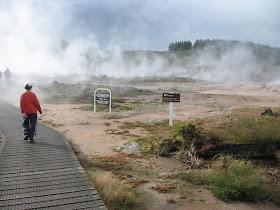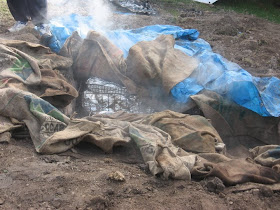This may be more of a challenge than last week. Either Smoke or fire or both can be in the pic, bonus for creativity…Have fun…:-) Ed.
For my take, this is a very New Zealand show. You do get it in USA, but here, the geothermal activity is still quite active. Once upon a time, there must be a lot of fire activity in the ground.
The Maori Goddess of fire is Mahuika. Mafuie is the Samoa goddess of earthquake god. Both stories tell of how man got fire. Zhu Rong AKA Li or Chu-jung is the Chinese god of fire and ruler of southern hemisphere. In Roman mythology, Vulcan is the god of fire. Fire is obviously a very important element to many people.




http://sundaystills.wordpress.com/





Geothermal area, The Taupo Region is a volcanic zone which contains some of the most violent thermal activity in the country. My father in law was afraid of the geysers and the howling sounds when the steam shoots up. It takes 30 minute walk visits bubbling craters, mud pools and steam vents.
In the 70s and 80s, it used to be free, but now they ask you for a donation of $6 to the volunteers who maintain the bathrooms and watch your cars. You can also see a lot of interesting plants that have adapted to thrive in the hot, steamy conditions. Enjoy this wonderful geothermal area despite the mild sulphur smell. It now has a wooden pathways with elevated viewing platforms.
My brother Charles and Sister in law Karen took me there in 1978. I fell in love with it. Charles jokes that this is heaven. Back then, the geysers were very strong. Charles says we were fairies in the clouds.
I went again with my kids and Sisters R and E.. Now you know why I like it.

This is Ho Mok Talay, New Zealand style. This Thai dish traditionally steamed in banana leaf cups has now morphed in Auckland and comes piping hot, smoking and on fire. It is in the form of a burning aluminium foil bomb which we dub as our Mt Eden Volcano.
Inside this alumnium foil mount exterior is a mixture of chopped calamari, mussels, shrimp and crab meat, mixed in an egg custard and steamed. It is spicy and soothing at the same time. My daughter likes it and she says it is very close to her Singapore favourite sea food, the chilli crab.
For her sake, whenever we go to the Thai House in Ponsonby, she orders this dish. You can't see the fire because I forgot to take the photo when it first arrived on the table.
In New Zealand, our natives, the Maoris have adapted their version of volcano cooking called the Hangi.







I was teaching my ESOL adult students what a Hangi is.
I was pleasantly surprised that In South America, they also cook food in a similar way. In Peru, Felecites tells me they call it Pachamanca, and in Chile, Monica says they call it Curanto. My Samoa students call it Umu.
In my other blog, annkschin.blogspot.com, I wrote about Hangis and my book, Mail order Bride., and short story, Nadine in various posts, but I didn't have a closeup photo. Here I am fortunate that Ngarimu's cousin invited me to take as many photos as I wanted.
Here are pix of the hot pit.
Cooking for a storm, chicken, pork, mutton, potato, kumara, pumpkin, cabbage, wholesome food cooked on site. Food wrapped in paper and alumnium foil placed in a basket and steamed in the ground for hours from hot stones.
The Maoris got this idea of a hangi from the hot thermal volcanic grounds where eggs can be boiled by lowering into thermal pools. In a Hangi, a big pit or more than one square yard is dug in the ground. Timber is burned, and stones are heated. The baskets of food are put into the pit and covered with jute sacks. Dirt is dug on top of the pit. The food takes a few hours to cook. It looks like a smoking volcano.
Next time, if I have the opportunity, I will get a photo of the burning logs.
Finally, no photo here. In Borneo, there is a lot of slash and burn farming methods. My parents make a big bon fire, and cover then fire with soil. They believe that this will kill off all the virus, grass seeds and make the soil fertile. Since the haze problem, this is stopped.
Three great sets of pictures to go with all your stories. Stories that I never heard and did not know about. I always learn something new here. I don't think I could eat something cooked in a thermal pool, ick!! I've just never seen the like, with all that smoke coming out of the ground! Is there any danger that part of this earth would erupt and hurt someone? How stable is it, anyway?
ReplyDeleteyou have a wonderfully informative blog and i do enjoy visiting....
ReplyDeletethankQ again for your comforting and warm words during my dad's passing; it's very much appreciated in case i have not thanked you before.
hugs,
lilian
What a great lesson Ann. Interesting cooking method. :)
ReplyDeleteVery cool post, and informative too..:-))
ReplyDeleteWonderful post Ann! Your posts are always informative. :D
ReplyDeleteGreat post and photos for smoke and fire!
ReplyDeleteI love these stories...lovely post as I nurse this great sadness in my heart and cannot sleep....so I read and read and read....it helps to read fresh and refreshing stories. And nice photos...I have become child like so blogs entertain me more than books because of their delightful photos. Thanks.
ReplyDeleteInteresting post, Ann. There are geothermal areas in B.C. not too far from where I live, it has become a hot springs tourist destination.
ReplyDeleteHangi sounds good. We had a pig cooked in a pit by a couple of guys from Samoa years ago. It was very good. Nice lesson too.
ReplyDeletevery cool photos
ReplyDeleteA very comprehensive blog Ann. I liked your photos of the Taupo volcanic region. - Dave
ReplyDeleteHi Ann, This was all very interesting..so different. Thanks for sharing! :)
ReplyDeleteGreat post.
ReplyDelete